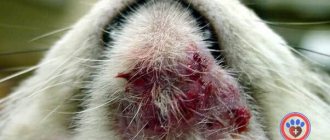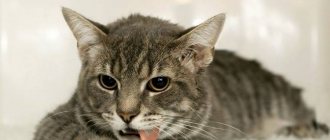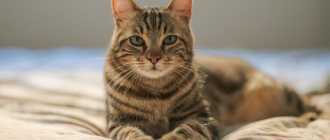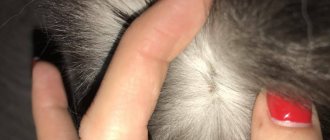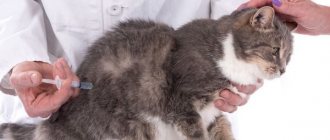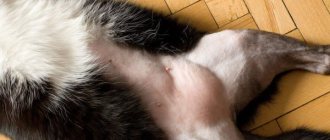Pet owners know that skin diseases are common not only to humans, but also to four-legged pets. Thus, you can often find acne on a cat’s chin - black spots and pimples that are not hidden by short fur. And in order to begin treatment correctly, you need to decide what causes this disease and what consequences it may entail.
At-risk groups
Veterinarians believe that the appearance of acne is not related to the breed, age or gender of the pet. Pathologies can be either isolated or regular, cyclical, depending on the cause of the disease.
Statistics show that castrated and sterilized animals are less susceptible to the disease, but even in this case its occurrence is not excluded.
Most often, acne appears repeatedly in cats, so it is important to completely cure the animal the first time acne appears.
In individuals with long hair, lesions may appear on the face and in the folds of the skin. The only exception is hairless cats (Sphynxes), due to greater sebum secretion than other breeds, these animals have a higher risk of acne. Careful care helps eliminate the risk of pathology.
Causes of acne in cats
Since acne can affect any pet, it is worth carefully studying the list of causes that provoke the disease:
- constant stress causes active work of the sebaceous glands;
- if a cat gets his chin dirty, you should understand that he will not wash it himself, and the dirt with microorganisms will remain on the skin;
- skin diseases;
- malfunction of the sebaceous glands;
- poor development of hair follicles (alopecia);
- weak immunity;
- plastic dishes, especially those that are not the first freshness, are a breeding ground for bacteria that have accumulated in their micropores.
Rashes on the skin can appear in both a kitten and an elderly cat, and despite this, sphinxes suffer from acne more often, and neutered cats and sterilized female cats suffer from acne in isolated cases.
Treatment with home remedies
In the mild, initial stages of the disease, the problem can be dealt with using home and folk remedies. Do not forget that acne treatment must be agreed upon with a veterinarian.
Sometimes treating blackheads with a two-phase makeup remover helps. By carefully blotting with a cotton swab moistened with the product, excess sebum and dirt are removed from the affected areas, and the skin is disinfected.
It is important to remember that this method can only be used in the absence of ulcers and inflammation.
If the nature of the disease is allergic, then changing the food or replacing plastic dishes with metal and earthenware usually helps.
If there are no ulcers, inflammations, or infected wounds, the use of folk remedies is acceptable. For example, lubricate acne with a mixture of two Furacilin tablets and chamomile decoction or fresh pumpkin juice. If there are a small number of blackheads and no pustules, lotions made from celandine infusion or yarrow decoction can also help.
What are pimples, acne and blackheads?
The skin of an animal has sebaceous glands, and there are more of them where there is less hair. These glands produce a special secretion (sebum or sebum). But sometimes too much is added or the consistency changes towards thickening. This leads to blockage of the gland duct and the formation of an inflamed area of skin. A fatty, viscous secretion, isolated from air, is an excellent “tasty” environment for the proliferation of pyogenic bacteria. The result of this process is acne.
If the secretion accumulates under the skin and the surrounding tissues become inflamed due to the proliferation of bacteria, this is called a closed comedon. If sebum comes to the surface, oxidizes and blocks the duct of the sebaceous gland, a blackhead (blackhead or open comedon) is formed.
Acne is a complex disease associated with inflammation of the hair follicles. Accompanied by acne with elements of both types and hyperemia at the site of the rash. In cats, they most often appear on the chin, a little less often on the ears and neck, and even less often in the tail area. The location of the rash is determined by the location of the sebaceous glands. In cats, most glands of this type are located on the eyelids and chin; there are quite a lot of them along the back in the area of the tail and foreskin.
Traditional treatment scheme
Veterinarians claim that with proper treatment of isolated cases of acne, a complete recovery of the animal is possible without relapses.
If comedones reappear, the cat will most likely need lifelong treatment and daily hygiene procedures.
When the disease is in an advanced stage, bloody scratches form in place of the blackheads and a secondary infection occurs - a fungal or bacterial infection of the skin. Timely contact with a veterinarian and comprehensive therapy will help prevent the disease from developing serious complications.
In complex treatment, the following drugs and procedures are prescribed:
- Antiseborrheic shampoos such as Lactaderm and Doctor. They contain sulfur, salicylic acid, benzoyl peroxide, ethyl lactate, which help remove fat and dirt and have a drying effect. Wash the animal once or twice a week.
- Products with local cleansing and antiseptic effects. This could be Chlorhexedine, Furacilin solution, Miramistin, hydrogen peroxide. In addition to disinfection, these drugs help relieve itching.
- Brilliant green or iodine - applied to the affected area after antiseptic treatment, dried and disinfected comedones.
- Ointments and gels with anti-inflammatory and drying effects - Flucinar, Levomekol, Tetracycline, Leniment synthomycin, syntomycin and zinc.
- Antibacterial ointments or gels, such as Mupirocin, Flemoxin salutab or Bactroban.
- Combined preparations in the form of ointments with benzoyl peroxide and antibiotic (Baziron, Zinerit).
- Retinoid ointments with vitamin A (Differin, Adacoin) have an immunomodulatory and anti-inflammatory effect, preventing follicle blockage.
- Systemic antibiotics are prescribed only in difficult cases - when blackheads turn into ulcers, follicles and infected wounds. 90 percent of acne diseases are cured without antibacterial injections. Amoxicillin, Enrofloxacin, and cephalosporins are usually prescribed.
How to care for a sick cat
It is better to shave the fur on the acne-affected area. Areas with blackheads and inflammation should be washed daily with tar soap and special gels. They are applied with a swab, then carefully washed off with a damp cloth and blotted dry.
Sometimes acne is steamed and blockages in the hair follicle are removed. A hot cotton napkin soaked in chamomile decoction is applied to the affected area.
In complex therapy, ointments and gels are used as adjuncts to prevent the formation of ulcers and inflammation and are used until acne completely disappears. They are applied for 30-40 minutes, then the excess is removed with a cotton swab.
Before using them, the skin is cleansed with antiseptic agents.
Sometimes castration helps in the treatment process; after this procedure, hormonal levels decrease and acne may go away on its own.
When using any external therapy (liquid solutions, gels and ointments) to prevent poisoning, you must ensure that the cat does not lick itself.
Squeezing out acne from your pet is strictly prohibited.
If pus spontaneously discharges from burst pimples, it is carefully removed with cotton swabs. When drying crusts form, they are not removed, but wait until they fall off on their own.
Signals of the onset of illness
Signs of the disease increase gradually, and attentive owners will definitely notice them:
- First, swelling and redness of the skin appears;
- then on the chin you can notice black dots that turn into ulcers and formations called infiltrates;
- the next stage of the disease is severe itching, which is caused by purulent and blood clots.
If you do not take immediate measures to treat the animal, scratching the itchy areas will lead to the formation of infected wounds. They, in turn, cause the appearance of bald spots, hair loss in the affected areas and their baldness.
Special diet
During treatment, the veterinarian will most often immediately recommend putting the cat on a special diet, eliminating any fatty and high-calorie foods from the diet. This is done in stages:
- Refusal of dry and canned food.
- Introduction of fiber and carbohydrates into the diet, usually in the form of porridges made from oatmeal and pearl barley.
- Adding vegetable or fruit stews and purees to the daily portion of food.
- Addition of vitamin complexes (ascorbic acid, vitamin A, tocopherol). It is important to observe their correct dosage. Excess can cause allergic reactions, and deficiency can cause vitamin deficiency.
The essence of the problem
The most common place where cat acne appears is the chin. Dark dots are least likely to be seen on the tail. Fleas or other parasites leave their waste products anywhere on the animal's body. In advanced cases, the spots on the cat’s fur are localized in the following areas :
- folds on the paws;
- inner thighs;
- eyelids;
- nipples;
- jaws.
© shutterstock
Dark spots can also be found around the anus. If multiple black rashes appear on your pet's skin, you should see a veterinarian.
Mr. Cat recommends: is there a danger to humans?
With any illness in an animal, there is a danger of infection and fear for the household. But in the case of cat acne, there is no need to worry - this pathology is absolutely safe for people. Caring for a sick animal will not bring any harm to a person.
Acne occurs for a number of reasons; this disease is not viral. Even small children, the elderly and people with a low immune background will never get acne from a sick cat.
Read the article about what a person can actually get infected from a cat.
Definition of disease
Acne is a multifactorial pathology in which comedones (blackheads) form on the skin of a cat’s chin. These formations occur with increased secretion of the sebaceous glands in conjunction with a disruption of the keratinization process in the stratum corneum of the epidermis.
Acne affects cats of any gender, age and breed, regardless of the conditions of detention.
There is no single cause for the appearance of blackheads in cats. Predisposing factors for their formation include non-compliance with basic rules of care and nutrition, stress, infectious and parasitic diseases.
Note! According to statistics, neutered pets practically do not get acne.
Prevention of comedones in cats
Acne is not a serious or dangerous disease, and the cat is not at risk of death. But this pathology is extremely unpleasant and causes a lot of anxiety for both animals and humans. If the appearance of acne is not caused by a genetic predisposition of the pet, its occurrence can be easily prevented by following fairly simple preventive measures:
- Do not use plastic bowls for feeding. It is better to replace them with products made of stainless steel or earthenware.
- It is necessary to ensure the cleanliness of feeding containers. It must be washed before every meal.
- Drinking water should always be clean. It is recommended to change it at least twice a day.
- The food should not remain in the bowl for more than five hours.
- Provide properly selected nutritious nutrition. Don't forget about vitamins and special supplements with Omega-6 and Omega-3 acids.
- Monitor your pet's hygiene. If necessary, wipe his chin after each feeding. This is especially true for the Persian cat. Due to the peculiar structure of her jaw, she practically cannot eat on her own, and always gets very dirty when feeding.
- The cat's skin and fur must be kept clean. Don't forget about timely brushing and bathing. Brushes should be used with soft to medium hardness. Trauma to the skin can easily lead to the formation of acne.
- If the cat is not intended for breeding, it must be neutered in a timely manner. This can prevent the development of pathology.
- Regularly treat your animal for external parasites.
- Monitor the cleanliness of the house, bedding, beds - all places where the pet spends a lot of time.
- Maintain normal temperature and, especially, humidity in the room where the cat is kept.
1111
Symptoms
If black specks appear on a cat's skin, the pet owner should check for other symptoms of the disease. For example, a cat may suffer :
- baldness;
- swelling of the body;
- redness of the skin;
- small pimples that increase in size and number over time.
Pay attention to your pet's behavior. The appearance of black dots on a cat’s body is often accompanied by itching, due to which the animal becomes restless and constantly itches. Only an experienced veterinarian can make an accurate diagnosis after conducting the necessary research work.
Diagnostic results help to find out the exact cause of the appearance of dark spots on the fur and skin of a pet. It may turn out that the grains are due to the activity of parasites, a fungal infection, or as a result of a skin biopsy. A timely veterinary examination will allow you to exclude similar diseases, which include :
- demodicosis;
- cat scabies;
- dermatophytosis;
- allergic reactions;
- eosinophilic granuloma.
The black dots that appear under the cat's fur are most likely skin plugs clogged with excess sebum, or a manifestation of an internal disease.
© shutterstock
